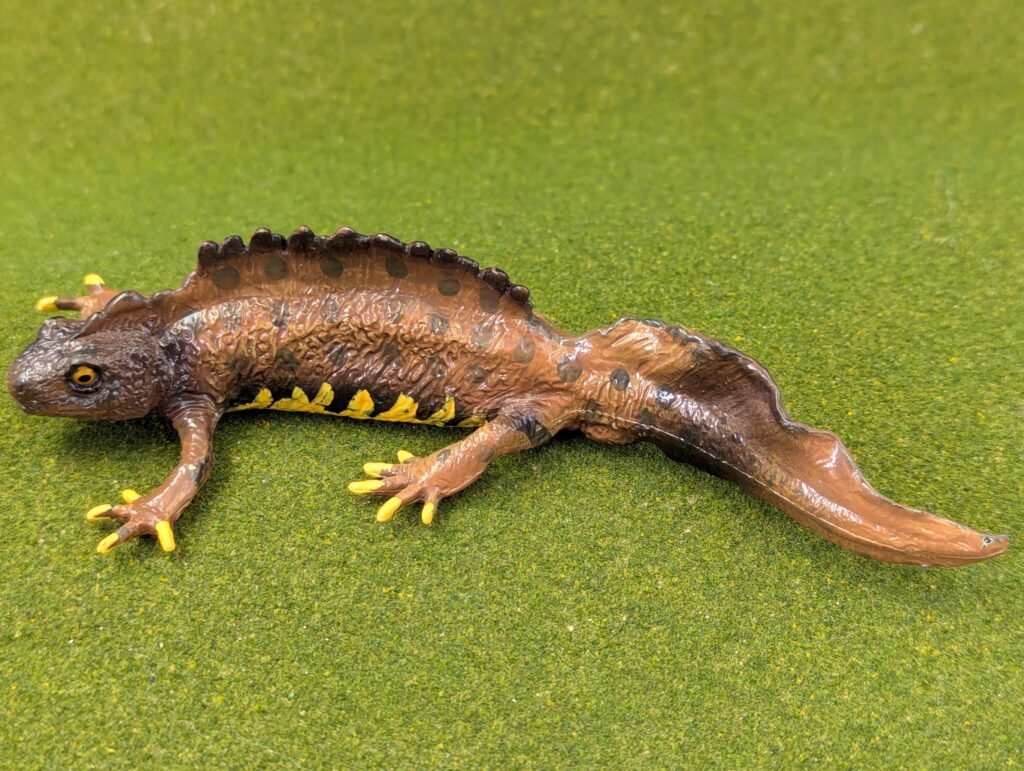
For the first time since I introduced the Tennessee Aquarium salamander figures with the fire salamander we are going back to Europe, the northern crested newt, Triturus cristatus, and this is also the last European species in the series. This one is item number 210572, the sixth and final figure in the original 1995 releases–and the penultimate figure in the series overall. This is the only ‘newt’ in the line, from the subfamily Pleurodelinae…a subfamily within the ‘true’ salamanders Salamandridae. So it’s the only newt and one of only two true salamanders in the Salamander Collection. Taxonomy meets vernacular! Of course, given this, I needed to find the difference between a newt and salamander…apparently newts are a specific type of salamander, noted for wartier skins, with a terrestrial juvenile phase and primarily terrestrial in their adult phases other than during breeding season. In the case of the northern crested newt, this involves some pretty major changes in the males’ morphology (reflected in the figure).
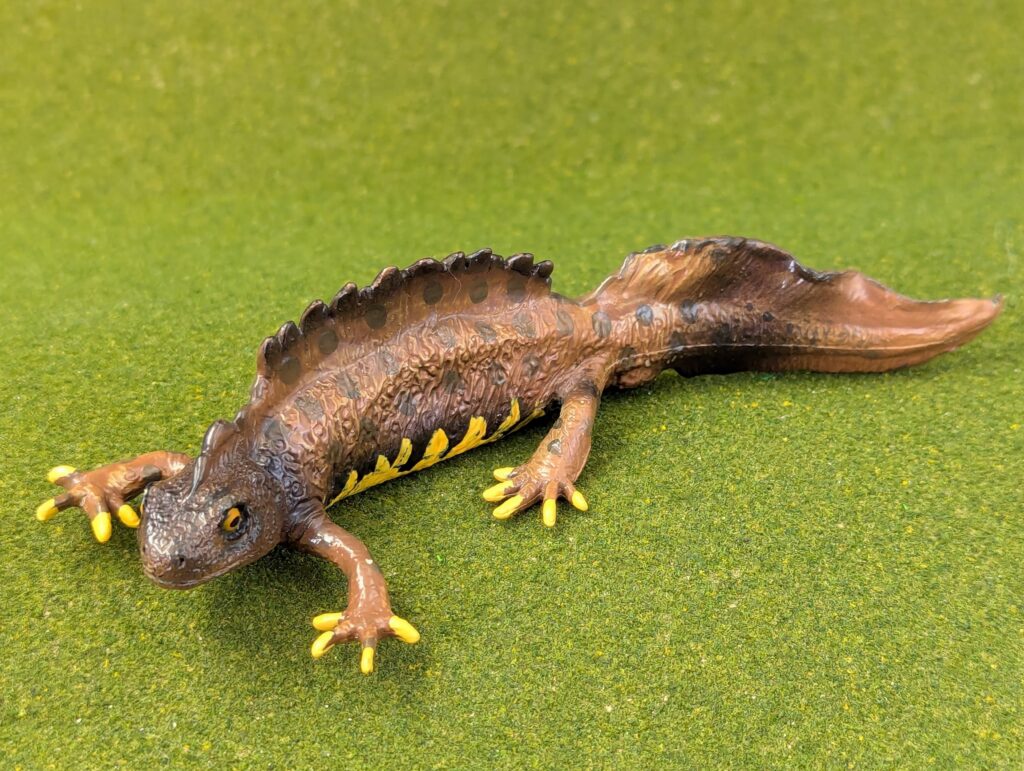
Northern crested newts are the most widespread of the Triturus newts in Eurasia, ranging from Great Britain across north and central Europe, and into western Siberia. The species was once considered more widespread, but some of those populations have now been determined to be different species; there are also a lot of synonymized species names. The northern crested newt is listed as Least Concern by the IUCN, although populations have seen declines, mostly due to habitat reduction; they are listed as a European Protected Species. They are predatory, eating whatever invertebrates are present in their environment as well as tadpoles in their aquatic habitat. Juveniles are preyed upon by a variety of animals, but adults tend to deter predators with colour displays and a milky, noxious substance.
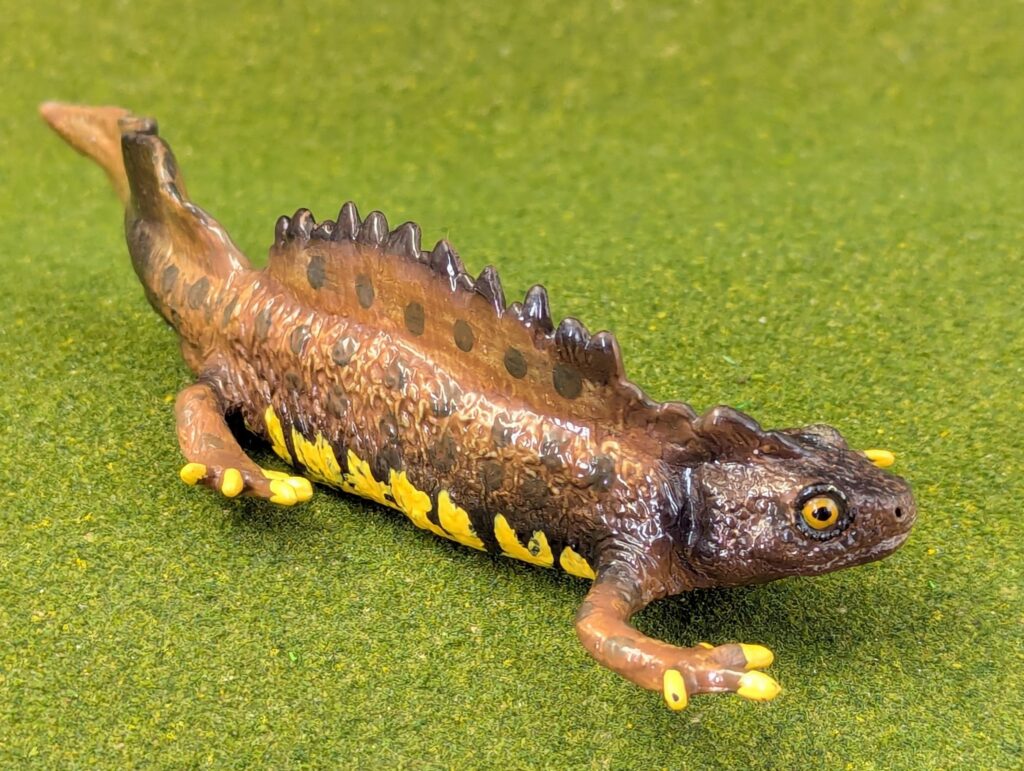
Northern crested newts are relatively large and slender, ranging from 13cm in males to 16cm in females (5.3 – 6.3 inches), occasionally larger. Like most newts, they are normally terrestrial predators, preferring damp, covered habitat such as woodlands or conifer groves, but will accept other dense-foliage habitats. In breeding season they head for stagnant, exposed bodies of water with no fish but lots of plants (even artificial ponds) and the males undergo a radical change in appearance, developing a high crest along the back and tail, as well as changes in colours. This makes it easy to tell that the Safari figure is a male in aquatic breeding phase.

The figure itself is unmistakable in what it represents. Despite being an aquatic-phase individual, it is sculpted flat, with legs splayed straight out as if on the ground; there is no indication of it swimming. The feet are tilted up a little, but in a manner that seems awkward for walking or swimming. The body is in a single left-curve with only a small curve to the right at the tail tip. Unlike the last several smooth-skinned salamander figures, the skin is sculpted to be slightly rough and warty, as would be expected; the head is especially rough with a high snout and bright yellow eyes under distinct brow ridges. The cheeks and throat are strongly defined, and the mouth is closed. The legs have thinner thighs than distal ends, with the back legs somewhat flattened all toes splayed out. The crests are of course the most obvious features, each of which is much thinner than the thick, hefty body from which they extend. The front crest begins low on the head and rises high along the entirety of the back; the top features a series of pointed tips, with no spines or other supports visible. At the hip there is a sudden gap, followed by the tail crest that extends continuously along the top of the tail, around the tail tip, and then back along the under side of the wider tail and ending at the prominent cloacal bulge; it most closely resembles an uneven isocercal tail of an eel…! The figure itself is 13.9cm long, so 1:1 scale with an adult male.
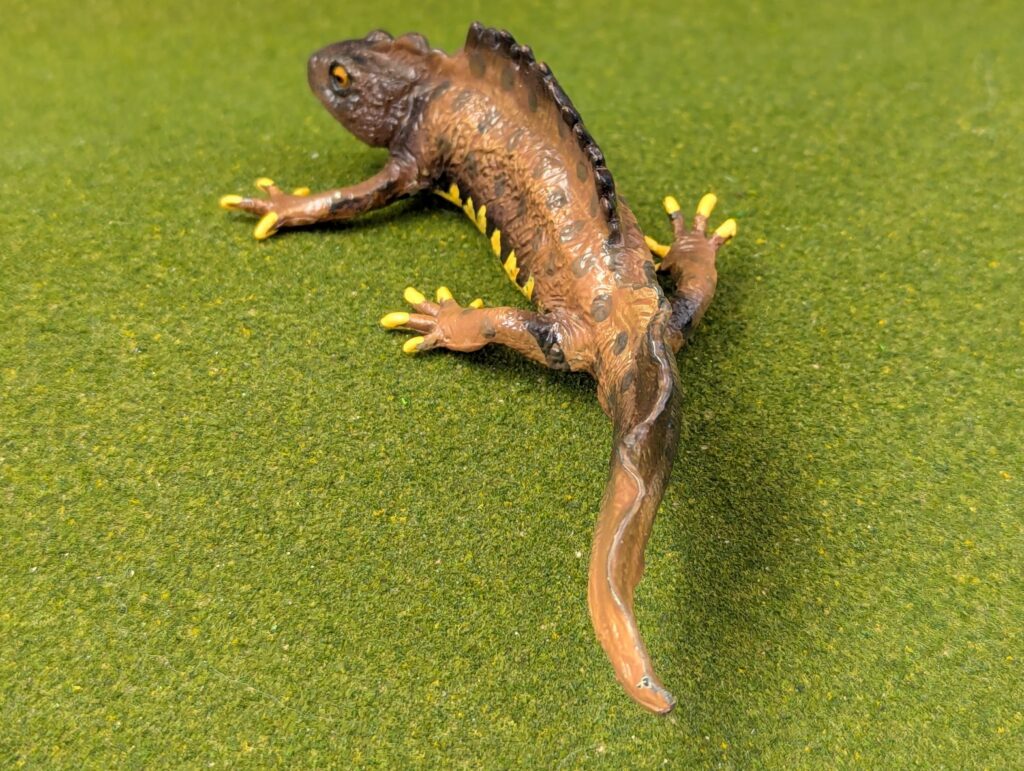
Describing the colouration is a challenge–crested newts have very elaborate patterns, and the Safari figure went all out trying to capture that. The overall colour on the back and sides is a lighter brown, with subtle grey spots on the sides and slightly darker tips on the crest. The tail is also the same brown with a few darker spots, withh a dark brown band extending all the way around near the widest part. The head is also brown, with more darker brown overtones. This same colour blends from the sides to the belly, which is highlighted by bright yellow marks reaching up from the belly.
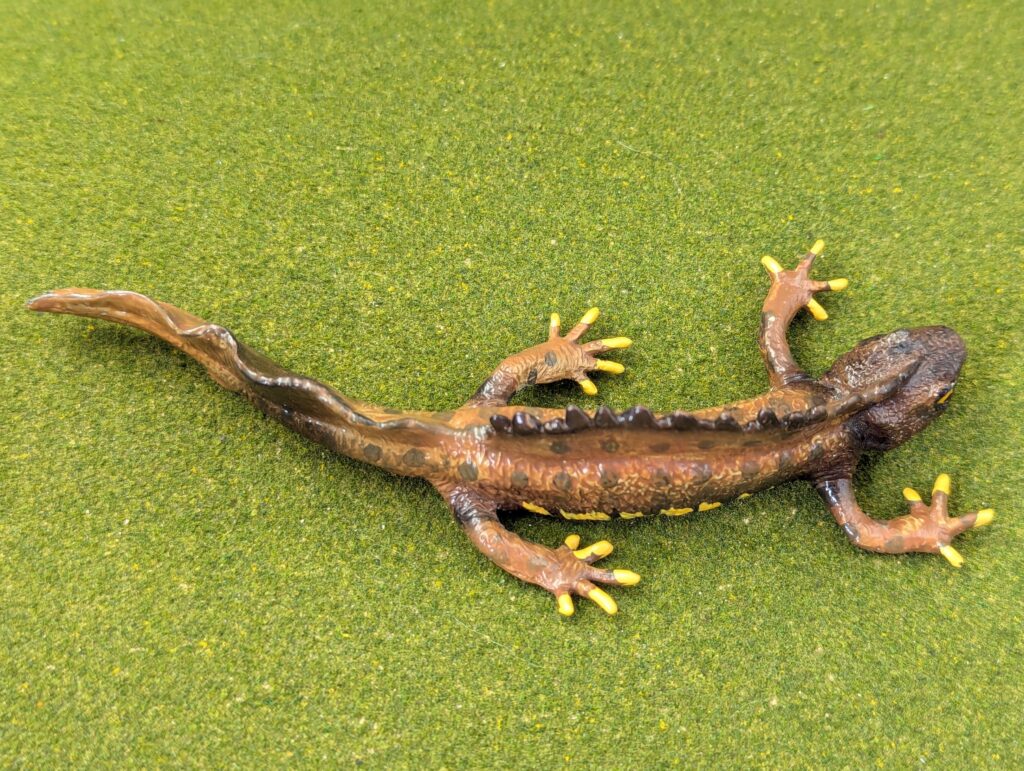
This same yellow can be seen on the toes, in bands under the legs, and in numerous little spots on the chin. The yellow of the belly itself is interrupted with black blotches. These are admittedly applied rather sloppily, with some being dark, distinct black markings, and others being faded or almost smeared; alternatively, the yellow paint is unevenly applied and does not conceal the underlying black properly. I think the issue is the latter; judging by the sides, the dark lower sides and belly were painted, followed by the yellow, and the coverage was not quite right. It’s a rare miss (keeping in mind I obtained mine in 2007 or so, so probably a much later run) as the belly markings on the real newts are uniformly distinct and solid.
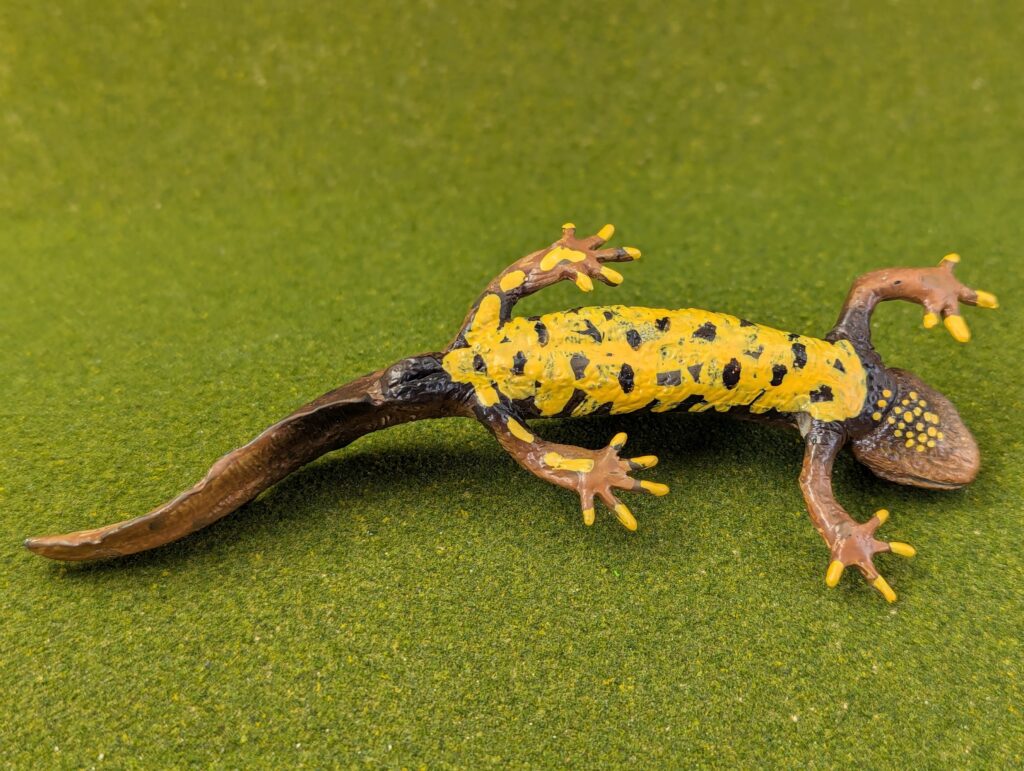
Once again, this is a wonderful piece (slight paint issues aside, and probably not a major issue in light of the fantastic sculpting work. For such a common and familiar animal, it is surprising that we don’t see more figures of animals like this (I am only aware of a small bin-style one that is nowhere near this level). This of course stands out as only one of two European species represented, in a field of 7; it’s too bad they didn’t add on (no Asian species, for example–and plenty of non-Appalachian species in the Americas). But next time I will be looking at the last official member of the series, the largest and most distinct of them all!

Disclaimer: links to Ebay and Amazon on the AnimalToyBlog are affiliate links, so we make a small commission if you use them. Thanks for supporting us!




Ha, you know I never thought about it until you mentioned it that a couple species in the set are European. For some reason I assumed everything was endemic to the Appalachian region or eastern N.A. generally, but I knew the marbled salamander was Palearctic.
Right? It took a while for me to put that together too; I’d also assumed it was all at least North American species! But looking at them closely kind of forced me to recognize it. Which means there’s still a lot out there to be made to full scale!
Right? It took a while for me to put that together too; I’d also assumed it was all at least North American species! But looking at them closely kind of forced me to recognize it. Which means there’s still a lot out there to be made to full scale!
Remote Reply
Original Comment URL
Your Profile